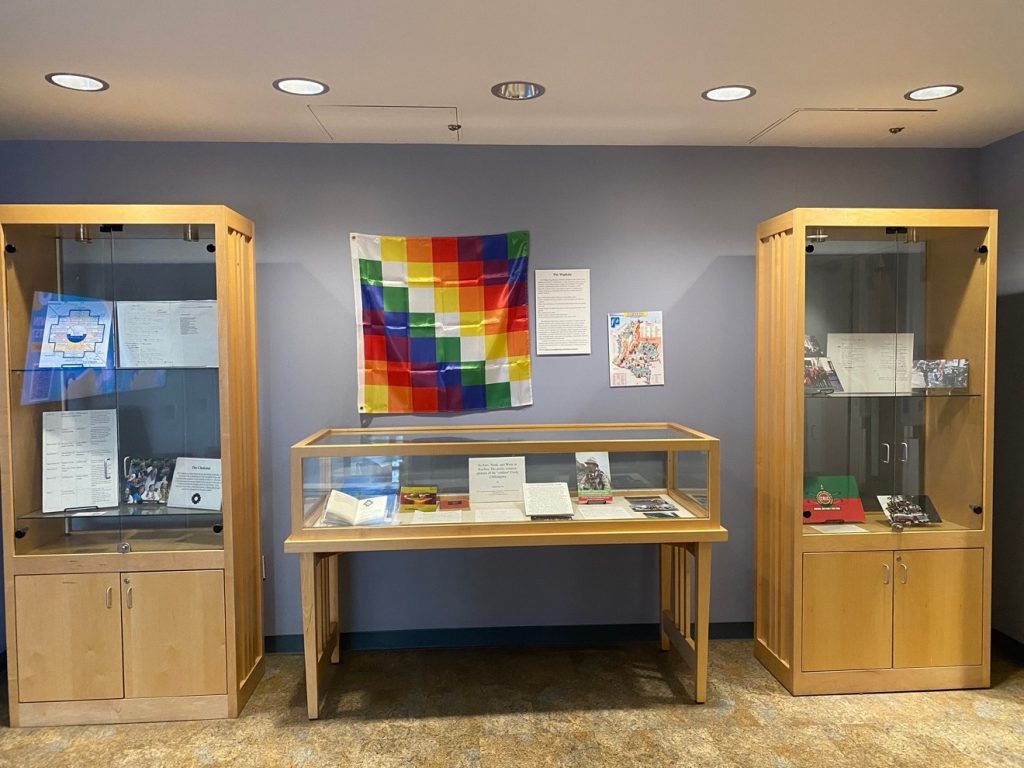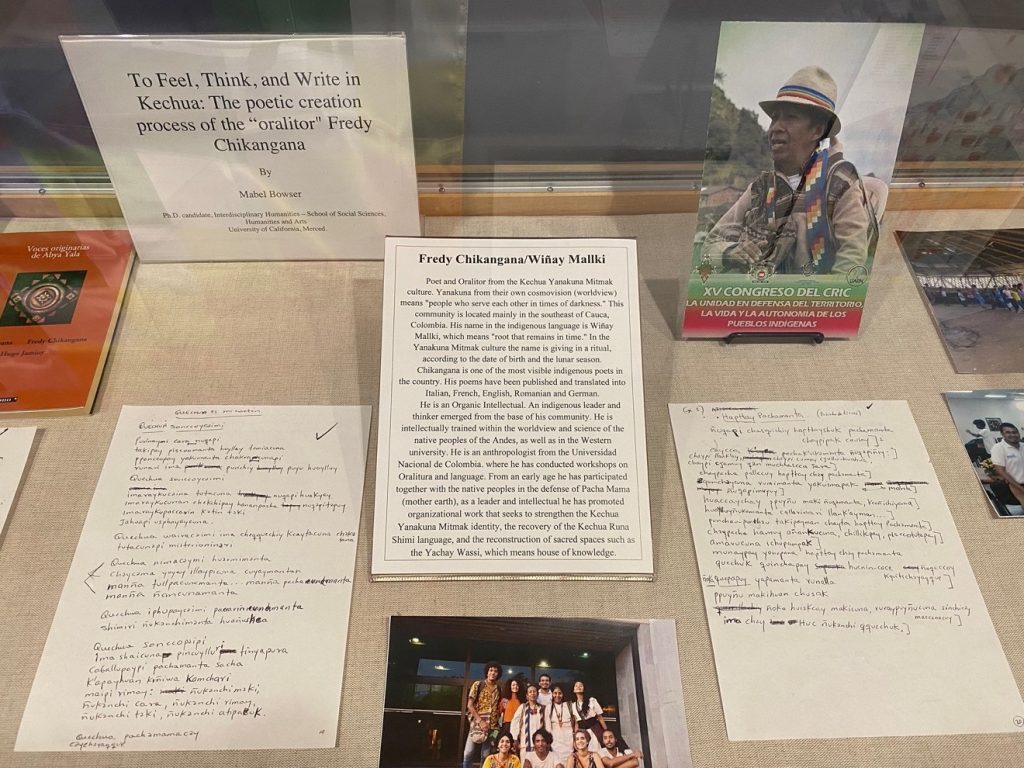by Mabel Orjuela-Bowser, Ph.D. Candidate in Interdisciplinary Humanities, UC Merced

This past summer, I met with Fredy Chikangana, one of the most visible indigenous poets in Colombia. In an email exchange in 2021, Chikangana had promised to send me the original manuscripts of a series of poems written in Quechua, at the peak of the 2021 protests in Colombia. Our meeting allowed me to receive some of them personally. Once I had the manuscripts in my hands, I leafed through them trying to guess, from the cross-outs and notes, the process of creating these poems, wondering about the experience of writing them during the protests, and the reason why the author initially wrote them in Quechua.
For context, I want to explain more about who the poet in question is and what the protests in Colombia during 2021 were about. Then, in my next blog, with his permission, I will share several of his original manuscripts, some of which are currently on display at the UC Merced Library, through May 31, 2023. My exhibit The Poetic Creation Process of the Oralitor Fredy Chikangana: To Feel, Think and Write in Quechuahas two main goals:
1- To introduce the viewers to one of the most important contemporary indigenous poets from Colombia and Latin America. This is an invitation to learn about his trajectory as an indigenous leader and as an intellectual from the Yanakuna Mitmak community. Viewers also have the opportunity to learn about this culture from the Colombian Andes.
2- To show viewers original manuscripts of poems written in Quechua Runa Shimi, a native language from the Colombian Andes, as well as printed copies of these poems in Spanish. The visual appearance of the printed version tells a story in a hegemonic language, while the Quechua manuscripts show us the author’s creative process and the importance of his mother language. This shows the viewers the process of feeling, thinking, and writing in his community’s mother tongue, as well as an idea of how the author crafted the bilingual final product.
The Indigenous Poet

Fredy Chikangana is a poet and oralitor from the Quechua Yanakuna Mitmak culture. The poet defines himself as an oralitor to the extent that his writing is carried out alongside his sources: the orality of the elders. Yanakuna, from their own cosmovision (worldview), means “people who serve each other in times of darkness.” This community is located mainly in the southeast of Cauca, Colombia. His name in the Yanacuna community is Wiñay Mallki, which means “root that remains in time.” His poems have been published and translated into Italian, French, English, Romanian, and German in national and international magazines and newspapers, including Etnografist (Sweden), Kontakt (Denmark), Poetry Internacional (Holland), Casa de Poesía Silva (Colombia), and Antología de literatura indígena de América (Chile). His poems are part of the Biblioteca básica de los pueblos indígenas de Colombia (Basic Library of the Indigenous Peoples of Colombia), several anthologies of Colombian poetry, anthologies of indigenous poetry of the Americas, and are the subject of multiple literary reviews and postgraduate theses and dissertations. He has published several books, such as Kentipay llattantutamanta / El colibrí de la noche desnuda (The Hummingbird of the Naked Night) and Samay Pisccok pponccopi muschcoypa/ Espíritu de pájaro en pozos del ensueño (Bird Spirit in Dream Wells). Chikangana is also co-author of Herederos del canto circular (Heirs of the Circular Song) and Voces de Abya Yala (Voices of Abya Yala). Currently, he is working on a book about sacred medicine. Chikangana has been recognized and awarded nationally and internationally with prizes such as the “Humanidad y palabra” (Humanity and Word) poetry award from Universidad Nacional de Colombia (1993) and the Nosside Prize for Multilingual Global Poetry held in Italy (2019).
The Social Outbreak in Colombia
The protests of April 2021 against tax reform, with which the government of Iván Duque sought to raise taxes on the middle class during the COVID-19 pandemic, became an unprecedented mobilization in recent decades in Colombia. It was a true social outbreak where different demands repressed for decades, which go beyond economic demands, came together. In addition to demanding a more supportive state to deal with the economic damage caused by the pandemic and a reform of the police, the mothers of the disappeared, the indigenous, Afro-descendants, people of different sexualities, women, youth, the poor, peasants, and the unions were fighting for a different country, for an organic democracy. This would be a country built from below by the citizens, one that responds to a new political ethics, which includes, among many others, the defense of the environment and the development of peace. The indigenous communities in Colombia, including the Yanacona people, participated and protected the popular marches with their minga[1] methodology (an Inca tradition of community work) and the Guardia Indígena[2] (non-armed indigenous guard).
As a result of this social uprising, there was an explosion of cultural expressions demonstrating social discontent about repression, as well as proposals for the construction of a country where we all could belong, where there is social justice and basic rights. Music, humor, caricatures, banners, literature, and many other manifestations flourished, capturing the facts and supporting the resistance. In this context, Chikangana accompanied the processes of resistance through the word, with which he illuminates another future for the protesters of the First Line[3] and all the racialized nations that co-exist in Colombia. As part of a border subjectivity, Chikangana writes these poems in Quechua and Spanish, two of the languages spoken in this territory of cultural diversity, to establish bridges of horizontal communication and reject the superiority of Spanish, the hegemonic language. With them, he reconstructs the origin and course of the current violence, which daily kills the hope of a country full of biological, cultural, and epistemic diversity. He expresses the hope of the peoples who resist and invites the construction of an organic, participatory democracy, built from below, which communalizes power.
The author is a poet, witness, and chronicler of the facts. Narrating from a situation of danger, he joins the marches and visits the different sites of resistance. Chikangana writes to the rebels in the heat of a historical rupture, of a social explosion that involves a new methodology (minga methodology). His poems represent an act of ownership of the protests, solidarity, fraternity, and accompaniment to the protesters. There is no waiting time for balsamic post-conflict poems.
Why Does the Author Write in Quechua?
On May 28, 2021, Chikangana presented some of these poems at the Poesía en Resistencia,[4] an event organized by Revista Prometeo. There, he explains that he begins his reading in Quechua to “remember the memory of our language present in our America, our Abya Yala.”[5] He needs to have the mother tongue of his ancestors present in order to keep the memory of their culture alive. Chikangana writes in Quechua Runa Shimi, the ancestral language of his community, because his poetry, although cosmopolitan and transnational, is rooted in his Yanakuna Mitmak culture. Keeping in mind the memory of his mother tongue is at the heart of his creative process.
According to the National Indigenous Organization of Colombia, ONIC, in the country “70 languages are spoken: Spanish and 69 mother tongues. Among them, 65 are indigenous languages, 2 Creole languages (Palenquero of San Basilio and that of the islands of San Andrés and Providencia – Creole), the Romaní or Romaníes of the Roma people – Gypsy and the Colombian sign language.”[6] The Colombian law 1381 of 2010, in its second article, recognizes that native languages “constitute an integral part of the intangible cultural heritage of the peoples who speak them, […] The plurality and variety of languages is an outstanding expression of the cultural and ethnic diversity of Colombia…”[7] However, the reality is that in Colombia, like in most of the countries of Latin America, the official history has been written from the position of an ethnocentric power, with a Eurocentric vision that excludes other ways of being within our nation. The discourse and social practice of exclusion, as Foucault would say, leaves the original peoples out of the national project, and the official history relegates them to a category inferior to “civilized” Colombia. Therefore, speaking and writing in Quechua or any other indigenous language is a political act, an act of resistance against the disappearance of a culture. It is an attempt to preserve its memory inside and outside the local indigenous community. Keeping the ancestral language alive preserves the world it names and describes. In the creative process of the author, the language linked to the territory guides the writing and it gives the Pachamama[8] a voice. The possession of a pre-Columbian language from the Andes gives authority to the Yanakona peoples as an original culture of Abya Yala. Quechua, as their mother tongue, provides cohesion and authority by connecting them with the Inca Empire. The use of Quechua avoids epistemic privileges and brings together the diversities that inhabit Colombia to establish a horizontal dialogue between them.
[1] Minga comes from the Quechua word minka, which means collective work. The minga is a process open to intercultural dialogue.
[2] The Indigenous Guard is conceived as its own ancestral body and as an instrument of resistance, unity, and autonomy in defense of the territory and the life plan of the indigenous communities. It is not a police structure, but a humanitarian and civil resistance mechanism. https://commonspolis.org/en/proposals/security-according-to-the-indigenous-guard-in-colombia/
[3] The First Line is a protesters’ defense group created two years ago in the anti-government protests in Colombia, against the government of Iván Duque. The main objective of the First Line was to repel the attacks and violence by the Mobile Anti-Riot Squad (Esmad).
[4] https://www.youtube.com/watch?v=c_4v9XmQFHc&t=48s
[5] Since 1977, the World Council of Indigenous Peoples agreed to use the pre-Columbian term “Abya Yala”, with which the Kuna culture refers to the territory that we know today as America. Abya Yala, in Kuna language, means “land in its full maturity” or “land of vital blood”. https://www.revistas.una.ac.cr/index.php/tdna/article/view/9712
[6] https://www.onic.org.co/noticias/636-65-lenguas-nativas-de-las-69-en-colombia-son-indigenas
[7]https://www.funcionpublica.gov.co/eva/gestornormativo/norma.php?i=38741
[8] Pachamama refers to the Mother Earth. “Pacha” in Aymara and Quechua means earth, world, universe. According to ancestral beliefs, Mother Earth takes the energy of the cosmos, the universe, time, and space. https://www.telesurtv.net/news/rituales-celebracion-dia-pachamama-20210801-0001.html
